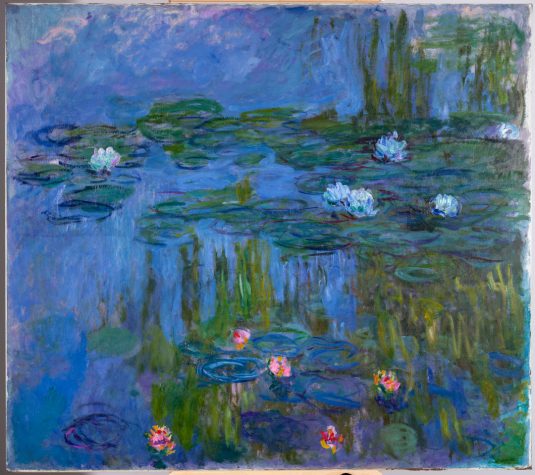
Monet’s Floating Worlds at Giverny: Portland’s Waterlilies Resurfaces
Portland Art Museum, Portland, OR - To Aug 10
One of the Portland Art Museum’s prize possessions, Waterlilies (1914–15) by French Impressionist Claude Monet (1840–1926), has been restored and is center stage in a new exhibition. Monet was experimenting with larger-than-easel-sized paintings of his lily pond in Giverny, France, and although he destroyed many works from this era, this one was a favorite. He gave it to his son Michel, who hung it in his dining room for 35 years before selling it to the museum in 1959.
That’s when it was varnished to protect it. The synthetic resin varnish made the painting darker and shinier, like the difference between a river rock when it is dry and when it is wet. This was exactly what Monet always said he did not want.
The museum’s chief conservator, Charlotte Ameringer, took the opportunity to restore the painting while the museum is being rehung before the new Rothko Pavilion opens in November. Ameringer spent months removing the synthetic resin varnish with cotton swabs and a solvent in PAM’s new conservation lab. The result is a lighter painting, where the subtle pastel shades of the light blues and greens are more noticeable. The surface is matte instead of glossy and the painting is displayed in a pool of light that resembles daylight, matching Monet’s plein air method.
Monet used viridian and other pigments, including a synthetic form of malachite, to create a range of green hues. Some of the waterlilies are simple ovals made with corrugated (patchy) brushstrokes, which show the texture of the paint beneath them. It’s a disorienting composition, all water and reflected sky and willow branches. Monet and his fellow Impressionists were obsessed with the Japanese “floating world” seen in woodblock prints, asking us to contemplate form over content and light waves over permanence.
Make sure you save some time for the accompanying exhibition, which uses the museum’s collection of Japanese prints to show their influence on Impressionists. If you thought manga and anime hit hard in the 21st century, the power of woodblock prints will blow your mind.

